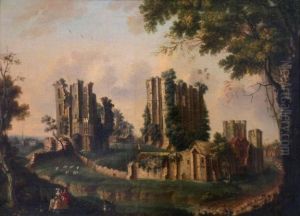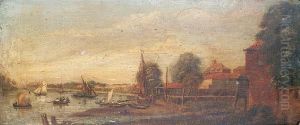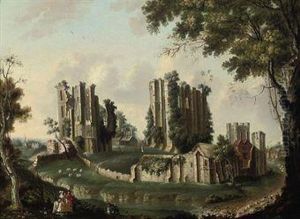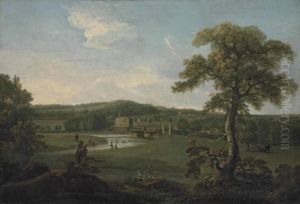Nicholas Thomas Dall Paintings
Nicholas Thomas Dall, an artist whose work contributed to the British landscape painting tradition of the 18th century, was born in Copenhagen, Denmark, in 1720 and passed away in 1776. While not as widely known as some of his contemporaries, Dall's contributions to the artistic movements of his time were significant, particularly in the realms of landscape and scenic art. His journey from Denmark to Britain, where he would make his most enduring mark, is a testament to the vibrant cultural exchanges that characterized the European art scene in the 18th century.
Dall's early life in Denmark provided him with a foundation in the arts, but it was his move to London that exposed him to the burgeoning scene of landscape painting in Britain. The period was marked by a growing appreciation for the natural world, influenced by the Romantic movement, which emphasized emotion and individualism as well as the glorification of the past and nature. Dall, integrating into this artistic environment, began to develop his unique style, characterized by careful attention to the subtleties of natural light and color.
Although records of Dall's training are sparse, it is believed that he studied under some of the prominent artists of his time, absorbing the influences that would shape his own work. His landscapes, often populated with figures and architectural elements, reveal an artist deeply engaged with the techniques of his predecessors while also experimenting with perspective and composition.
Dall's work during his time in Britain caught the attention of patrons and fellow artists alike. He was particularly noted for his ability to capture the British countryside with a vibrancy and realism that spoke to the sensibilities of his adoptive country. Despite this, Dall never achieved the level of fame enjoyed by some of his contemporaries. His contributions, however, were recognized by those who valued the evolving landscape genre, and his paintings were exhibited in several prestigious venues of the time.
Nicholas Thomas Dall's death in 1776 marked the end of a career that, while not celebrated in the mainstream narratives of art history, played a role in the development of landscape painting in Britain. His legacy, preserved in the collections that house his work, continues to offer insights into the artistic exchanges and influences that enriched the European art scene in the 18th century. Dall's life and work exemplify the journey of many artists of his era, navigating the complexities of patronage, stylistic evolution, and the pursuit of artistic recognition.




